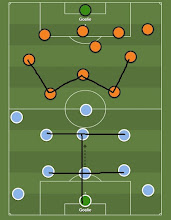The Argentine boss, Bruno Pesaola, was the gaffer who led Bologna to win
their last title in 1974.
Ahead of Bologna’s first Coppa Italia final in 51 years, which will be held
on May 14th in Olimpico Roma, it would be perfect to look back at how they won
their last silverware and the important man behind their last success. He was
none other than their gaffer, Bruno Pesaola.
His name was probably unpopular compared to the likes of César Luis Menotti,
Juan José Pizzutti of Racing Club, Omar Sívori, or Vladislao Cap, who rose to
prominence in the 1970s. They were even appointed to takege of the Albiceleste
in that decade. Yet, Pesaola left his own legacy abroad, especially in Italy.
His decision to switch sides to Gli Azzurri was probably the reason which
made him less well-known on his homesoil. Pesaola established his career in
Italy both as a player and as a manager. It was his role on the touchline which
made his reputation really take off. His best spells were with three Serie A
sides, Napoli, Fiorentina and Bologna, from the 1960s to the early 1980s.
Napoli (1962/63; 1964-1968; 1976/77; 1982/83)
His first club as a manager was Scafatese in the lower league before moving
to his former club as a player, Napoli, in January 1962. At that time, Il
Partenopei was on the verge of relegation to Serie C, but he managed to turn
things around and led them to promotion to the top flight as well as snatching
the Coppa Italia title. It was the first trophy in the club’s history, and they beat SPAL 2-1 in the final. His team also remains the last second-tier side to
win the Coppa Italia in history. Unfortunately, his second season in charge saw
Napoli return to Serie B in summer 1963.
Meanwhile, his second stint was more successful. He took charge of the team
when they were still in Serie B in 1964 and managed to guide them back to Serie
A in 1966. Within three seasons, Pesaola brought them to finish third, fourth
and second place consecutively till 1967/68.
He returned for the third time to San Paolo in 1976 after his success in
Bologna. Napoli’s campaign was sadly not as great as expected. They only sat
seventh in the final standings and were knocked out in the Winners Cup 1977
semifinal. His last spell in Napoli came in the middle of the 1982/83 season.
The former left winger had a disappointing result. Ramon Diaz and Co. could
only finish 10th at the end of the season.
Fiorentina (1968-1971)
Pesaola arrived in Florence in 1968, after his second spell in Napoli. The Argentine-born
boss surprisingly was able to guide La Viola to clinch their last Serie A title
in his first season. They collected 45 points and are four points clear of
Cagliari and AC Milan.
Sadly, his following two seasons did not end well. Amarildo and Co only sat
fourth in the 1969/70. Their European campaign did not continue to the European
Cup semifinal, as they were beaten by Glasgow Celtic, who came out as the winner in the competition.
Fiorentina even finished in the 13th place, barely relegated to the lower
division.
Bologna (1972-1976; 1977-1979)
The manager who earned only one international cap during his playing years
finally ended up in Bologna. After his woeful campaign in Firenze, Pesaola did
not achieve instant success. In his first season, he was only able to lead them
to finish 11th. In fact, Bologna never sat above seventh place in Serie A
during his tenure. Rossoblu only stuck in the mid-table in his first stint
there.
However, in the 1973/74 campaign, Pesaola finally had his moment as he
guided them to clinch their second domestic cup title in history and the last
silverware to date. Roberto Vieri and Co started off their campaign by
finishing as a group leader in the first group stage ahead of Pesaola’s former
side, Napoli. In the second group stage, once again Bologna sat on the top of
the table ahead of duo Milan giants plus Atalanta. Pesaola’s men took advantage
of AC Milan’s and Inter’s stars’ divided focus ahead of the 1974 FIFA World
Cup.
They eventually lifted the trophy after crushing Palermo 4-3 on penalties in
the final. Bologna was trailing one goal from the 32nd minute as Sergio
Mistrelli opened the scoring. They had to play with only 10 men as Roberto Vieri, the father of Christian Vieri, former Italian international forward in late 1990s and early 2000s, was sent off. Pesaola’s men were forced to wait till a
few seconds before the final whistle to find the equaliser through a Guiseppe
Savoldi penalty. The game went to the shootout, and Rossoblu won after
Palermo’s last two executors missed the target.
The Argentine gaffer’s second stint in Renato D’Allara was not successful.
His team only finished in the bottom half of the table in two consecutive
seasons. Pesaola then left the club to sign for Panathinaikos in summer 1979.


Comments
Post a Comment